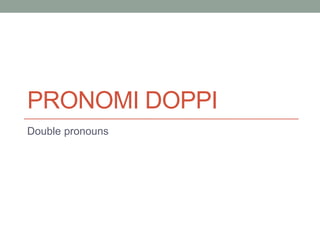Pronomi combinati
- 2. When are they used? • Many times a same verb has both a direct and an indirect object. • I lend my car to Maria • Both objects can be replaced by a pronoun: • I lend it to her • In Italian, the indirect object pronoun precedes the direct object pronoun and the indirect object pronouns mi, ti, ci, and vi change to me, te, ce, and ve:
- 3. Forms (indirect pronoun + lo/li/la/le or ne): Pronome indiretto LO LA LI LE NE mi me lo me la me li me le me ne ti te lo te la te li te le te ne gli / le glielo gliela glieli gliele gliene ci ce lo ce la ce li ce le ce ne vi ve lo ve la ve li ve le ve ne gli glielo gliela glieli gliele gliene Loro can also be used instead of gli. In this case the structure of the sentence is as follows: Presto la mia macchina a loro ‚Üí la presto loro.
- 4. Position (1) • Like all pronouns, double pronouns precede the conjugated verb: La macchina? Gliela presto domani Arance? Te ne compro due chili. Again, like all pronuns, they are attached to an infinitive: Arance? Vado a comprartene due chili. (comprare + tene)
- 5. Position (2) • With dovere, potere volere + infinitive, they can go • Either BEFORE dovere, potere, volere: La macchina? Non gliela voglio prestare. • Or AFTER the infinitive (and therefore attached to it) La macchina? Non voglio prestargliela.





